The Long (gone) Bien Festival
 |
Review: The Long Bien bridge Festival of Arts
On my way back from the Long Bien bridge Festival of Arts, I couldn’t help but feel shamed, insulted and outraged. Undoubtedly, this event has beaten everything else off my ‘Things never to see or do again’ list. If you’re asking, “Is it really that bad? People seemed to love it!”, then my answer is: either you have not seen it or been there yourself; or have been charmed by the on-paper ideas proposed by the organizers; or the press has once again outdone themselves and successfully fooled you into believing that this was going to be a once-in-a-life-time cultural event.
For a long time, the Long Bien Bridge has been considered an enormously significant historical site and icon of Vietnam. Not only has it survived several attacks during the French and American wars and witnessed the many ups and downs of Hanoi, it has also become an important and familiar part in the everyday lives of the people here no matter who they are, what they do or where they’re from. Trains carrying travellers from other parts of the country go over this bridge to enter Hanoi. Workers cycle and ride past every morning and every night to get to work or go back to their sweet homes. Couples hang out here and exchange their words of love to one another; kids use it as a playing field; old people do all sorts of exercises up and down the place. Youngsters like me head out to the bridge to get some fresh air and watch the lights go out as the city falls asleep, and the sun rises as the morning comes. Although we may identify with it differently, we are all breathing, experiencing and living this special communal space. In so many ways, the bridge has become a medium and a bond uniting the past and present, the old and the modern; and bringing people of all generations closer to one another.
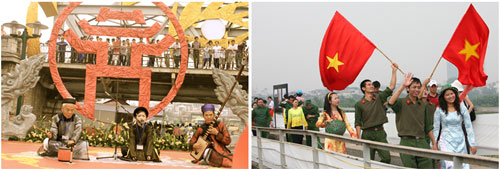
However, that bond was what’s severely lacking and ignored at the festival. Like an all-you-can-eat Chinese buffet, there was an unnecceserily large amount of activities and events happening at the same time, during the two days. Sadly, none of them was really worth seeing or paying attention to. Concerts of ca tru, cheo, tuong, quan ho; performances such as a traditional fashion show, a reenactment of Hanoians greeting soldiers marching back from their victory, a lion dance, an ethic parade; events like releasing lanterns onto the river, displaying fireworks, hosting a flute kite flying show, walking for peace; and activities including stalls serving traditional foods and drinks, selling books and postcards, portrait painting and photographing, storytelling, juggling etc. – are things that have been done obsessively and repetitively in almost every so-called “traditional and cultural event/festival” held around the country. They promote an aged and outdated approach to organizing events/festivals, to celebrating special occasions/national days, and to producing/appreciating arts. An approach that anyone with the least sense of style, judgment of aesthetic values, creative ability; or with a limited financial support could have adopted easily.
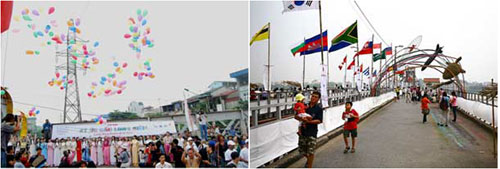
The kinds of arts exhibited on, off and around the bridge are also one of the many issues that could and should have been thought of, planned and discussed intensely and carefully beforehand. It was rather naïve of Maison des Arts (the organizers of this festival) to think that they would be able to shorten the distance between the arts and the people by simply introducing and bringing a hodgepodge of arts – including handcraft, photography, painting, drawing, installation, performance, calligraphy, printing and sculpture – outside and onto the bridge. First of all, there is a need to understand the difference between arts made for a space and arts made about a space. The works displayed here were clearly about the bridge and the artists’ perceptions and memories of it; but none of them were made or tailored to fit in, complement or challenge this space. For an exhibition site as overwhelming as the Long Bien bridge, the arts must have enough ability and strength to outdo the supremacy it holds; or at least go side by side with it. Otherwise it would become lost, unneeded and forgotten.
Secondly, although Maison des Arts did manage to encourage a kind of interaction – by presenting two white canvases along the sides of the bridge and letting people write their thoughts and create their own artworks on them – they obviously couldn’t foresee (or possibly chose to ignore?) the other set of meaning this brought about. Looking from afar, the color and shape of the canvases reminded us of headbands worn by family members of the deceased during a traditional Vietnamese funeral ceremony. According to the brilliant in-theory plan, they aimed to transform the bridge into a dragon. But does it make any sense or follow any logic to build the head and tail with some sort of golden foil, whilst illustrating its body as two thin pieces of white cloths?
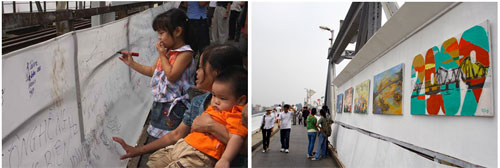
The bridge itself is already a beautifully crafted and momentously meaningful work of art. If one aims to breathe new air into this space, they will have to be very careful in order not to interfere with the many levels of meanings, significances and histories it holds. Playing with its architecture and structure is a fine way to approach this, but the most important here is what and how one plans to do so. Every little thing taken away or added to, every twist or move made, every detail or material used has its own role and meaning, therefore they must be chosen and employed with great care and for the right reasons. Otherwise the consequence would be no different than what we had seen with the Long Bien bridge Festival of Arts – something along the line of an unrehearsed play, unprofessional performance, immature exhibition and poorly organized event.
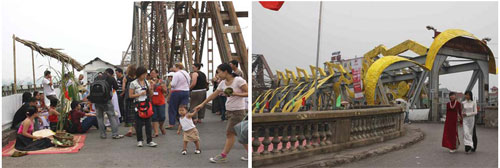
In many ways, the festival has become purely a vehicle to market oneself; and a platform to propose and perform other purposes, such as to mark the 999th birthday of the city, the 55th anniversary of the Liberation Day of Hanoi, the 10th year Hanoi has been named a ‘City for Peace’… The more “clothes” and “make-up” put on the bridge, the less recognizable it became. It was no longer the meeting place we all fell in love with. Its function and originality were lost; its most ordinary and everydayness were stolen; its bond uniting the past and present, the old and the modern; and bringing people of all generations closer to each other was destroyed. As audiences, we were bombarded with the quantity rather than the quality of the events; and left feeling confused and isolated from all this excessive chaos surrounding us – one with no clear or coherent aim and focus.
Maison des Arts seemed to have been too over-the-top and over-ambitious, and were holding so many illusions and hopes with this project that it backfired on them massively. They obviously misjudged our perception of art and doubted our level of appreciation for it. The kinds of arts they introduced were not fresh and innovative enough to sparkle up new sensations and discussions; rather they were a means to over-celebrate and over-worship the aged and plain. The festival might have made an impression on tourists and people from out of town; but totally excluded us and ignored what we had to say or how we felt about it. The organizers need to realize that both the psychological and physical position, role and importance of the Long Bien bridge and those of its people are interchangeable, that one cannot function or survive without the other. “Long gone?”, I hope so. Because it’s time we asked ourselves whether we want to see and experience a “cultural disaster” like this happening every year. It’s time our voices heard and our opinions respected. It’s time we got asked, got involved and made some changes. But “Long gone?”, I don’t think so. Because this is something people are probably going to discuss and criticize for at least another 999 years.
[*] Images taken from various sources.
![]()
| Bill Nguyen is a fine arts graduate from Nottingham Trent University, England. He has recently returned to Hanoi and writes on contemporary art in Vietnam. |



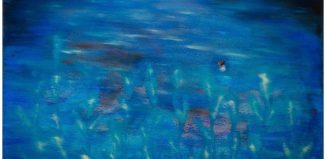










Tôi rất đồng ý với Bill Nguyễn về bài viết này và Maison des Arts cũng nên đọc để biết cảm giác thực của nhiều người khi tới tham gia festival cầu Long Biên. Ngay từ buổi sớm tới “thưởng thức” đã phải chứng kiến đội múa rồng mà những động tác cơ bản cũng không thuần thục. Họ “cuốn” con rồng như cuốn cuộn len rối và nhiều đoạn thân rồng mắc vào nhau khiến người xem phì cười, có lẽ họ mới tập luyện với nhau chừng nửa ngày trước khi biểu diễn. Maison des Arts đã tham vọng qúa! Nhìn cái cách bày trí sơ sài bằng tre với nứa đã thấy ở đó sự rẻ tiền và nhạt nhẽo. Nó không xứng tầm với cây cầu lịch sử của Hà Nội. Cũng có thể thông cảm chút xíu nếu kinh phí tổ chức hạn hẹp., nếu thế., giá như., hãy thu gọn vào một nơi, không gian nhỏ cũng tốt nhưng phải là một chương trình nghệ thuật đích thực.
Quả là khi nghe về một lễ hội hoành tráng ở cầu Long Biên mình đã rất háo hức, mong chờ một lễ hội đặc biệt, ấn tượng. Nhưng kết quả là khi ra về: ngậm ngùi.
Thanks for this stunningly honest message, Bill. The best thing everyone can do – with the exception of the authorities with the money to restore the bridge – is to leave the bridge alone. It is, as you noticed, a living work of art and so enjoyed by precisely the people it needs to be by: those who use it – those who cross it, live under it, work on it, live on it, shoot drugs on it, recreate on and under it. The organized use of it is pointless and Maison des Arts’ “festival” was more an act of self-aggrandizement and ego than a bridging of the gap between ‘arts’ (popular or otherwise) and the people.
Of course it was a failure on every level. It could be nothing but. But perhaps having touched a low point in contemporary culture and art, we now have point of reference to which we need never return. One can hope……
This is a cleverly worded and well written article that describes extensively what the author feels was wrong with the Long Bien Festival – that it dressed up the bridge with well used, and included well known cliched festival activities. Bill makes some interesting observations “looking from afar, the color and shape of the canvases reminded us of headbands worn by family members of the deceased during a traditional Vietnamese funeral ceremony”. He says that the Festival organisers ” totally excluded us and ignored what we had to say or how we felt about it” -though he does not say what he does feel or how he was ignored.
The author did not make any suggestions as to how the “ordinaryness” and “everydayness” that were “stolen” could have been celebrated or how the community could have felt less isolated from the celebrations. Also, if he actually had any suggestions to make, Bill did not illustrate how the organisers could align these suggestions with the expectations of the funding bodies- who may or may not have his modern approach or artistic understanding to presenting community festivals.
I had nothing to do with the Long Bien Festival, neither do I have any cultural attachment to the bridge. I do not know the politics or any of the organisers though I do know they accessed volunteer workers. However, I have long successful career in events organisation and volunteering (working very hard for no financial reward to benefit others and the wider community) which makes it difficult for me to accept this article,beautifully scribed, as it is, as anything other than a big moan- from someone who has not contributed to the development of the event in any way. Bill Nguyen points out all of the faults but makes no suggestion of how it could have been improved.
I say to all the “takers” of the world. It is easier to criticise than help, and make valuable suggestions and act on them yourself. Put up or shut up.
Upon visiting Long Bien bridge on the 2nd day of the festival and having a limited prior historical/cultural understanding behind it, I hopes of being more or less educated through the event. As a spectator, I enjoyed the arts displayed and it was nice to see how different artists drew inspiration from the bridge to their work. However, I rarely see someone taking the time to appreciate a piece (it did became difficult to do when the bridge is crowded) as opposite just randomly snapping pictures and passing by. Since it’s only a two-day event, would it be better if the artists themselves were present to engage some of the audiences? I also question the purpose of the photos displayed, where they following a timeline? Or just memorable moments strung together? It would be helpful to include a description.
The white canvas didn’t bother much as to the oddly shaped the golden structure that supposedly was to make the bridge look like a dragon from afar. It’s the least consistent element with other things in the exibition and doesn’t do a whole lot. Furthermore, I definitely agree that the event was mingled into other promotions and somehow the bridge itself – a historical architecture with many significances that needs no fancy promotion, got overshadowed by random stalls selling food and drink. I wanted more information presented about the bridge and its place in amongst us, the people and our city and culture :)
The single good thing is that I saw many young people taking interest in the event along side the older generations. Now they may be posing and taking pictures 99% of the time but I guess the young group that takes aesthetic and intellectual interest in this event is a minority.
Tôi không đủ kiên nhẫn và hứng thú để tới xem lễ hội này, ngay sau khi nhìn thấy bộ áo lòe loẹt mà người ta khoác lên cầu long biên. Có cảm giác đây là một nỗ lực của BTC nhằm đại chúng hóa nghệ thuật, tuy nhiên những giá trị phổ quát nhưng thiếu tinh tế (nói thành thật là rất thô thiển) đã tầm thường hóa hình tượng của cây cầu lịch sử này. Có nhất thiết phải khoác áo rồng một cách phô trương như vậy không, khi giá trị thẩm mỹ của chúng thực sự cần xem xét lại. Rác rưởi và những thứ con người xả ra đây còn có thể dọn sạch được, nhưng ô nhiễm thẩm mỹ và rác nghệ thuật thì tác hại thật khôn lường.
rất hy vọng Bill Nguyễn đến tham dự Hanoi Street Art Festival 2009 tại Quảng trường lý thái tổ, ngày 3/11/2009…
Right on Bill! “It’s time our voices heard and our opinions respected. It’s time we got asked, got involved and made some changes…”
I totally disagree with somebody’s comments above who finds it difficult “to accept this article,beautifully scribed, as it is, as anything other than a big moan- from someone who has not contributed to the development of the event in any way.” It’s such a cheap way to attack a critic. It’s like saying to a film critic he has no right to criticize since he hasn’t contributed to the development of the films!! Yes, we do have rights to criticize public events even when we don’t work on it precisely because we are the public whom the events are supposed to serve. Especially when we get insulted! In my view, Bill’s review is completely thoughtful, and kind!